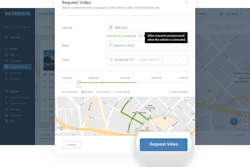 Omnitracs discontinued selling 3G versions of its IVG platform in December 2018. Since then all shipments have been 4G LTE.
Omnitracs discontinued selling 3G versions of its IVG platform in December 2018. Since then all shipments have been 4G LTE.In the United States, an estimated 7.5 million Internet of Things (IoT) devices connect vehicles and drivers to their fleets through 3G cellular networks just two years ago, according to technology research firm Gartner. The number of 3G devices in service declined rapidly over the following two years.
With the sun setting on 3G, many fleets will be looking to squeeze the remaining life out of investments in aging hardware, but for how long?
Generally, telematics and IoT devices sold in 2018 onward use 4G LTE modems. For companies that use older devices, the 3G network coverage they have relied on for critical driver and vehicle status information may start to deteriorate.
Verizon has already announced plans to shut down its 3G service after 2019 and AT&T recently said it expects a 3G shutoff to be completed by 2022.
To that end, Verizon stopped accepting new 3G-CDMA subscriptions to its network after June 30, 2018, and AT&T blocked new 3G-GSM activations in 2019.
Shifting strategies
Mark Eisenberg, chief executive of Orbcomm, believes the sunsetting of 3G will have major impacts on technology suppliers, comparing the business climate to “throwing your chips in the middle and distributing them again.”
The migration of 3G to 4G will likely create new winners and losers in the market.
Orbcomm’s asset tracking and monitoring systems have satellite and cellular connectivity, depending on its customer needs. One area where the company has seen major demand for its latest 4G and satellite offerings is from transporters of temperature-sensitive freight.
 For more than two years, Trimble Transportation Mobility has been offering 4G LTE platforms — the PeopleNet Mobile Gateway (PMG) and PeopleNet Connected Gateway (PCG).
For more than two years, Trimble Transportation Mobility has been offering 4G LTE platforms — the PeopleNet Mobile Gateway (PMG) and PeopleNet Connected Gateway (PCG).“This is the year of the reefer container,” he says, and notes that Orbcomm is in the process of closing deals to deploy its technology on an additional 300,000 to 400,000 reefer containers.
Interviews with major telematics suppliers discovered that companies are offering discounts and incentives to their customers to migrate to 4G.
“We didn’t want to force any migration in the U.S. or Canada,” says Ray Greer, chief executive officer of Omnitracs. Greer says the company no longer ships 3G devices. It discontinued that practice starting this year with its IVG platform that is 4G LTE-enabled.
John Binder, director of wireless operations for Trimble, says that fleets will continue to migrate from 3G to 4G beyond the cutoff dates given by Verizon, AT&T and others. After these dates the networks will no longer guarantee the quality of their 3G service.
The 3G network is like a major interstate, he says, and the cutoff dates are when the Department of Transportation will no longer maintain the road. The road will still be usable but eventually it will become unnavigable.
Trimble Transportation Mobility, formerly PeopleNet, has about 250,000 devices in the field that have some exposure to sunsetting CDMA and GSM networks, he says. Trimble has a multi-network operator architecture that enables its devices to select and use any CDMA or GSM carrier that is available.
For more than two years, Trimble has been offering 4G LTE platforms — the PeopleNet Mobile Gateway (PMG) and PeopleNet Connected Gateway (PCG). For customers that use its older 3G devices, Trimble has internal reporting that gives it visibility to the 3G networks its customers are using and their service levels, he says.
With this reporting, Trimble provides customers with information about any degradation in 3G service they may have experienced or can expect to experience, particularly with Verizon since its sunset date comes first.
“We feel a deep responsibility to be completely open and transparent as to what is occurring,” Binder says. For instance, some areas may have a reduction in overlapping 3G cell sites, which may constrict their communications to one channel.
“We have knowledge that this much has already occurred on the (3G) networks,” he says. “The coverage looks the same, but the ability to carry traffic at a high level of service diminishes over time.”
While many fleets will continue to use 3G devices for a couple more years, “the minute they feel some impact they will want to upgrade,” he says.










